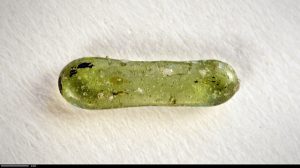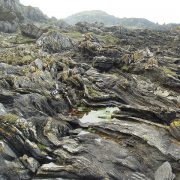Radioactive glass gives clues to Moon’s origin
Men have probably spent more time contemplating the Moon and its origins than any other celestial body, except perhaps the Sun. Over time, we have concocted dozens of theories about where the Moon came from, but we’ve lacked the evidence to support or disprove most of them. Some unique glass may change all of that.
In July 1945, the first nuclear test – code named Trinity – created a radioactive glass known as “trinitite.” The glass, which extended about 350 meters outward from the blast site, was created from materials on the desert floor at the time of detonation. Trinitite has a green color, and is slightly radioactive, but it also has some unique properties that are similar to those found in moon rocks collected during the Apollo missions.
Some traces of trinitite remain at the original blast site, and the material is thought to be safe to handle, but it is now illegal to scavenge the material. In the 1940’s and 1950’s however, collectors often picked up trinitite and it still circulates among collectors.
But what does trinitite glass have to do with the Moon? A researcher at the Scripps Institution of Oceanography at the University of California San Diego believes that zinc and other inclusions in trinitite mimic what happened during the Moon’s creation. The most popular theory of how the Moon came to be involves a cataclysmic collision between the Earth and a wayward planet-sized body. The collision produced debris, which eventually developed into the structure we know as the Moon.
Zinc and other “volatile elements” vaporize at high temperatures. The trinitite that was created closest to the 1945 blast site is depleted of these volatile elements, while trinitite created farther from Ground Zero contains a higher concentration of volatile elements and less overall depletion. As it turns out, moon rocks show the same depletion of volatile elements as the trinitite closest to the blast site. This supports the theory that a violent, high-temperature event produced the debris that later became our Moon.
While many people would argue that nothing good has come from the nuclear age, it is possible to use the residual materials from the blast to help us understand more about our planet, and moon formation in our universe.
Glassprimer™ glass paint is a specialized glass coating that bonds permanently to glass surfaces. GlassPrimer also makes a glass surface molecular activator that is designed to work with UV-inkjet glass printing processes. Glassprimer™ glass paint can be used in both interior and exterior applications and can help reduce solar heat gain in some applications. For more information about Glassprimer™ glass paint, please visit the rest of our site. If you’d like to purchase Glassprimer™ glass paint, please visit our online store .
Photo Credit: Mouser Williams, via Flickr.com




